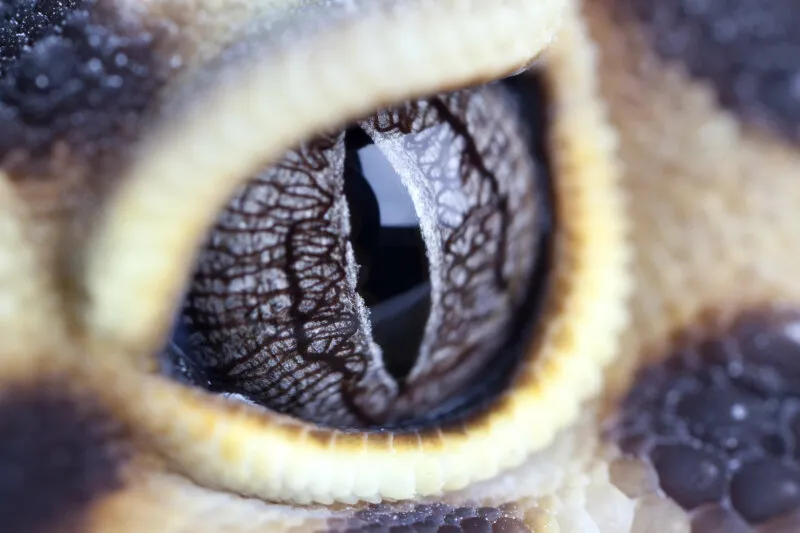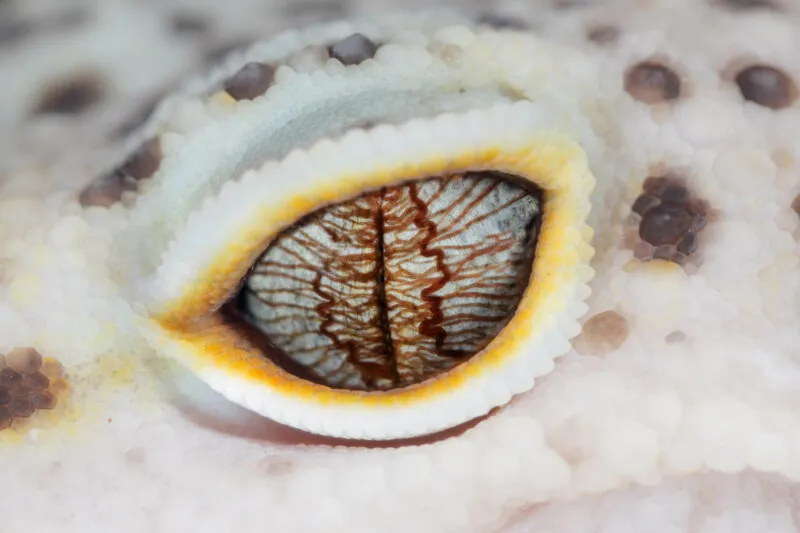
You probably know that your leopard gecko tends to be more active in the evening and early morning than they are in the middle of the day. But just how well can your gecko see during the night?
Leopard geckos can likely see as much as 350 times better at night than humans can. They are able to see color at night as well, making them unique among vertebrates, even those that see well in the dark.
Here’s what you need to know about just how well leopard geckos can see at night, as well as what their night vision means when it comes to feeding them and lighting their terrarium in the evening.
Table of Contents
Do Leopard Geckos Have Night Vision?
Leopard geckos not only have night vision, but they have significantly better night vision than humans. Geckos eyes are as much as 350 times more sensitive than human eyes in dark conditions.
Where humans only can see dim shades of black and white, geckos can see in color.
Geckos are unusual among vertebrates in that they don’t just see well in the dark, but can detect color as well. Most nocturnal animals give up color vision so that they can have better sensitivity to light in the dark.
This isn’t true when it comes to leopard geckos. Geckos have such specialized night vision that they are even being studied in order to improve night vision cameras and other technology.
Leopard geckos have such good night vision that they are actually some of the only vertebrates that are able to distinguish between even subtle color differences like blue and gray in extremely dim light.
In one study, geckos were trained to eat off of tongs that had either a blue or a gray card attached to them.
When they ate off the blue card, they got a delicious bug. When they ate off the gray card, they got a cricket that had been dipped in salty water– not nearly as appealing. The geckos learned to seek out the blue card in order to get the more tasty insect.
The scientists decreased the levels of light until they were using an extremely dim light that mirrored the light cast by a dim moon. The light was so low that the human eye could not tell the difference between the blue and grey cards.
However, the geckos ate off of the blue cards twice as often as the grey ones, indicating that they were able to tell the difference between the colors and choose the juicy insect over the salty one even with very little light by which to see.
How Leopard Geckos See in The Dark
You may suspect just by looking at a leopard gecko that they have decent night vision. The large, cat-like eyes suggest good night time visibility. In the wild, leopard geckos often tend to be more active at night.
In their native Asia and Middle Eastern deserts, daytime temperatures can be extremely warm during the summer months. Therefore, leopard geckos are active at night when it is cooler.
Geckos have evolved from lizards that were active only during the day. These lizards had only cones, not rods. Cones are useful for detecting color when there is a lot of light to utilize. Rods are good for seeing in the dark, but don’t pick up color.
Over the years, leopard geckos have developed superb night vision as they have become more active in the evening, despite not having rods.
The color receptors in their eyes became gradually more sensitive, enabling them to see very well at night and even be able to make out colors with minimum amounts of visible light.
Their cones became oversized and able to detect certain light wavelengths. While they don’t have any rods, they do have three different cone types.
They developed vertical pupils that close to little slits during the day to block out the intense sunlight when they need to bask during cool winter months.
Most of the time, when we see leopard geckos under the normal lighting in the terrarium, this is how their eyes look.
However, if you see your leopard gecko with a night vision camera, you’ll see that their pupils expand to cover almost the entire area of the eye to let in the most amount of light possible in the dark.

Geckos have also developed a number of other techniques to give them good visibility at night and during the day.
Their eyes are equipped with multifocal lenses that let different parts of the lens focus on different wavelengths. This unique adaptation enables them to focus on all colors.
When the light is bright and a leopard gecko’s pupil is as narrow as possible, two sets of pinholes are created along the vertical slit of the pupil.
These four small stacked pupils keep too much light from entering the eye while still enabling the multifocal lens to get enough light to focus properly and perceive distance accurately.

Their eyes are even designed to help the leopard gecko blend in with the environment during the day.
The iris is the same color as the scales in leopard geckos that have not been bred to have significant color morphs, which enables them to almost vanish into their rocky wild environments.
Lights You Can Use To Observe Your Gecko Without Disturbing Their Light-Sensitive Eyes At Night
Your leopard gecko doesn’t need any lighting at night. It is very important that they are not provided with a bright light at night, as it will interfere with their circadian rhythm and prevent them from going through normal night-day cycles.
Leopard geckos are crepuscular, which means that they tend to be most active at dusk or dawn. Often their activity extends into the evening, but they need a pattern of daylight and nighttime darkness in order to behave normally.
However, many leopard gecko owners want to be able to see their leopard geckos at night. You may also wonder if ambient lighting in the room will affect your pet’s circadian rhythm.
In general, as long as the ambient lights in the room are significantly dimmer than the lighting in your leopard gecko’s enclosure, circadian rhythm will be maintained.
However, if you keep your leopard gecko in a room that has very bright lighting other than the cage lighting at night, it may be a good idea to cover the cage to block out some of the light and enable a more natural rhythm. If you’d like to be able to see your leopard gecko at night, you have a couple of options:
1. A camera with night vision
A simple surveillance camera with night vision can be set up in front of your leopard gecko enclosure so you’ll be able to see what they’re up to even after dark.
Look for a camera with infrared HD night vision (this one gets the job done) to give you excellent surveillance of your leopard gecko’s behavior without interfering with their circadian rhythm. A camera like this is also great for checking in on your gecko anytime day or night.
2. Black light
It is very likely that your leopard gecko will be able to see some of the light put out by a black light, but it will be much dimmer than their daytime lighting and so may maintain their normal daylight schedule.
Black lights can be a cool way to observe lighter-colored morphs of leopard gecko. They should not be used all night, but are fine for an hour or so in the evening.
3. Red or blue light
Red or blue will not interfere with your leopard gecko’s circadian rhythm as much as white light, but they will still be able to see it. Keep in mind that because geckos can see color at night, a red or blue light will interfere with their ability to see the color of their environment in the evening.
They may be less likely to accurately detect
While it is fun to be able to see your leopard gecko at night, particularly since they tend to be more active at night, it is important to keep in mind that keeping a light of any kind on all night will interfere with your gecko’s natural circadian rhythms.
Whatever kind of light you’d like to use to view your leopard gecko, it’s best to only keep it on for a couple of hours in the evening.
One good option may be to use a highly customizable lighting option that enables you to program a sunrise, sunset, and evening lighting modes.
You can choose exactly how much light you want to be admitted at various times a day and where on the color spectrum you want the light to fall.
By choosing a small amount of blue light, you can replicate the fading evening sun and the sunrise, which can actually help to maintain a circadian rhythm for your leopard gecko at the same time as it gives you the opportunity to view your gecko.
Keep in mind that this kind of light won’t provide heat, but it can be sufficient for daytime lighting when paired with a ceramic heat emitter.
Can Leopard Geckos See Feeder Insects In The Dark? Should They Be Fed At Night?
If you feed your leopard gecko in complete darkness, you’ll find that they are as accurate at catching their
In fact, since your leopard gecko’s
Another advantage to feeding your leopard gecko at night is that many types of
Nighttime feeding may be more natural and more effective for your leopard gecko than feeding your pet during the day.
You can provide dim light in the evening so that you can observe your leopard gecko feeding or you can use a night vision camera to enable you to see them feed even when there is nearly complete darkness in their terrarium.
How to Provide Heat Without Light for Your Leopard Gecko at Night
Many people choose to heat gecko enclosures using an overhead light since this is a more natural and safer option than heating pads or heating rocks.
Although your leopard gecko does not need any light during the day, and in fact benefits from not having light at night, they still need a source of heat during the evening.
To provide heat without light safely, choose a ceramic heat emitter that does not send out light (like this one). This bulb can be used day and night to provide consistent heat, or you can alternate between this and a heat lamp that does emit light during the day.
If using it day and night, you can choose a UBA/UVB bulb that does not emit much heat but is helpful to replicate natural sunlight and enable plant growth during the day.
Marvel at Your Leopard Gecko’s Unique Vision
Leopard geckos have truly unique eyesight, able to see color at night better than most other species.
Many owners are surprised to learn just how good their leopard gecko’s nighttime vision is as well as how adaptable their geckos are to be able to see in the bright desert daylight or in the complete darkness of night.
Make sure that you keep your leopard gecko’s need for nighttime darkness in mind when you are setting up their terrarium.
- Enchi Ball Python: A Unique and Stunning Morph of Python regius - March 27, 2025
- Emerald Tree Monitor: The Enigmatic Green Guardian of the Rainforest - March 26, 2025
- The Egyptian Cobra (Naja haje): A Fascinating Serpent - March 25, 2025
